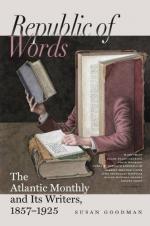The Duomo is an edifice of the Romanesque period, and contains some masterpieces by Mino da Fiesole. On a fine day, however, the church is too dismal, and the scene outside too glowing and golden, to permit any compromise between nature and Mino. The view from the Franciscan convent upon the brow of the hill, site of the ancient acropolis, is on the whole the very best which can be obtained of Florence and the Val d’ Arno. All the verdurous, gently rolling hills which are heaped about Firenze la bella are visible at once. There, stretched languidly upon those piles of velvet cushions, reposes the luxurious, jewelled, tiara-crowned city, like Cleopatra on her couch. Nothing, save an Oriental or Italian city on the sea-coast, can present a more beautiful picture. The hills are tossed about so softly, the sunshine comes down in its golden shower so voluptuously, the yellow Arno moves along its channel so noiselessly, the chains of villages, villas, convents, and palaces are strung together with such a profuse and careless grace, wreathing themselves from hill to hill, and around every coigne of vantage, the forests of olive and the festoons of vine are so poetical and suggestive, that we wonder not that civilized man has found this an attractive abode for twenty-five centuries.
Florence is stone dead. ’Tis but a polished tortoise-shell, of which the living inhabitant has long since crumbled to dust; but it still gleams in the sun with wondrous radiance.
Just at your feet, as you stand on the convent terrace, is the Villa Mozzi, where, not long ago, were found buried jars of Roman coins of the republican era, hidden there by Catiline, at the epoch of his memorable conspiracy. Upon the same spot was the favorite residence of Lorenzo Magnifico; concerning whose probable ponderings, as he sat upon his terrace, with his legs dangling over Florence, much may be learned from the guide-book of the immortal Murray, so that he who runs may read and philosophize.
Looking at Florence from the hill-top, one is more impressed than ever with the appropriateness of its name. The City of Flowers is itself a flower, and, as you gaze upon it from a height, you see how it opens from its calyx. The many bright villages, gay gardens, palaces, and convents which encircle the city, are not to be regarded separately, but as one whole. The germ and heart of Florence, the compressed and half hidden Piazza, with its dome, campanile, and long, slender towers, shooting forth like the stamens and pistils, is closely folded and sombre, while the vast and beautiful corolla spreads its brilliant and fragrant circumference, petal upon petal, for miles and miles around.




